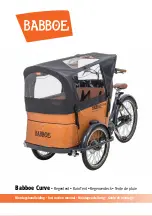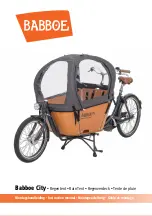
16
4.10 Ground clearance
When going over very rough ground, it is possible, but unlikely, that the underside of the frame could make
contact. If you think there is a chance that the underside of the frame may hit an obstacle, get off first and
look under the trike to see how close things are getting. You will quickly learn to recognize terrain that your
trike can easily handle. If you do contact the underside of the frame then, it's unlikely any serious damage will
be done (other than scratching the paint) but check to make sure everything is OK. A good way of riding over
obstacles is to aim your trike so that the object goes directly under one of your feet. This way it misses the
front wheel, the central frame, and the rear wheel.
4.11 Muscles
The first few times you ride your new trike, you will feel the muscles on your legs working harder than you may
be used to. This is because pedaling from the recumbent position uses different muscle groups than riding in
an upright position. You will find a noticeable improvement in this in a few days, and with a couple of months,
you won’t notice anything different at all.
When you are riding a recumbent, the best approach is to keep your cadence a little high, even if it means
gearing down a little early. One good reason for this is that the recumbent seat allows you to brace yourself
when you push on the pedals, and this makes it possible to put large loads into your knees. On an upright
bike, if you pushed that hard, you’d lift yourself out of the saddle. Also, try to remember to shift down before
you come to a stop; you will find starting off again to be much easier.
5.0 Maintenance
Your ICE trike has been built from quality materials and parts, and will last for many years with just a bit of
simple maintenance. Although there is nothing on the trike that a bike shop can’t maintain for you, doing your
own basic maintenance gives you a good feel of how your trike is working.
5.1 Lubrication
TIP - as with any cycle, a small amount of regular care will prolong the life of your
trike and its components. The simplest thing you can do is to regularly give a
quick drop of oil to all of the moving parts especially after riding in heavy rain.
Always keep the chain and chain tubes oiled.
Lubricating the Chain
At regular intervals, and always after riding in wet weather, you should lubricate the chain. The chain tubes
supplied with your ICE trike will help keep the oil on the chain by protecting it from rain and dirt, prolonging
chain life. Check with your local bike shop to see which chain lube works best in your area. It is not
necessary to use a lot of lube on the chain; better to use a little every week than a lot once a month. Wiping
the chain down occasionally with a dry cloth will help keep it clean and prolong its life.
Other lubrication
Rear hub, head set and pedal bearings on your trike will need greasing from time to time depending on riding
conditions, the same as any conventional cycle. The plain bearings in the suspension pivot need no
lubrication. If they show any significant wear (unlikely), they are simply pushed out and replaced with new
ones.
The steering ball joints don’t require lubrication.
The front hub bearings, handlebar (stem) bearings, and pulley bearings are pre-lubricated and sealed. If they
feel rough or sloppy, they should be replaced.
5.2 Adjusting cables
Cables don’t normally need a lot of adjustment. When they are new, they will stretch slightly, and that stretch
needs to be adjusted out of the system. Check all cables regularly for signs of damage.












































